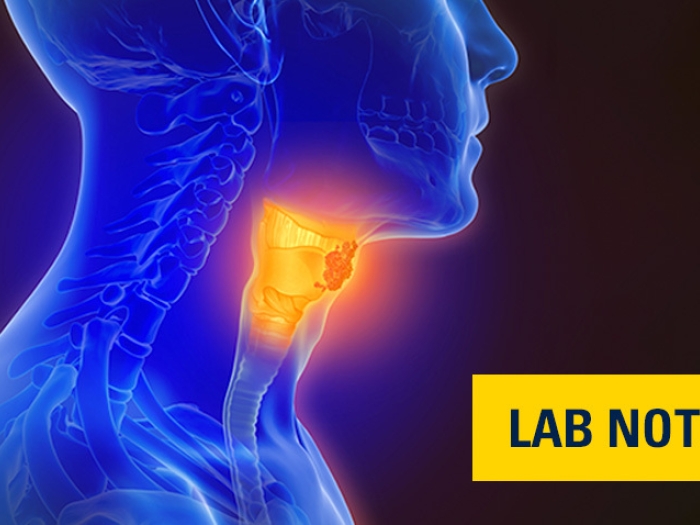At home test can detect tumor DNA fragments in urine samples, providing a non-invasive alternative to traditional blood-based biomarker tests
3:30 PM
Author |

Researchers from the University of Michigan Health Rogel Cancer Center have created a urine-based test that detects pieces of DNA fragments released by head and neck tumors. The test could potentially facilitate early detection of this cancer type, which currently does not have a reliable screening method.
Human papillomavirus (HPV) is widely recognized for causing cervical cancer but is increasingly found to cause cancers in the mouth, throat and other head and neck regions.
Early detection is critical because detecting a cancer at an earlier stage can lead to better outcomes for patients.
Small size
Using whole genome sequencing, the Rogel group showed that cell-free DNA fragments released by tumor cells, which are passed on from the bloodstream into urine through the kidneys, are predominantly ultra short, with fewer than 50 base pairs. Given their small size, these fragments are likely to be missed using conventional urine or blood based liquid biopsy tests in detecting circulating tumor DNA (ctDNA).
The research was led by Muneesh Tewari, M.D., Ph.D., professor of hematology and oncology, J. Chad Brenner, Ph.D., associate professor of otolaryngology-head and neck surgery, and Paul L. Swiecicki, M.D., associate medical director for the Oncology Clinical Trials Support Unit at Rogel. Initial results are published in JCI Insight.
“In this study we provide evidence to support the hypothesis that conventional assays do not detect ultrashort fragments found in urine, since they are designed to target longer DNA fragments. Our team used an unconventional approach to develop a urine test for HPV-positive head and neck cancer ctDNA detection,” said study co-first author and research specialist Chandan Bhambhani, Ph.D.
Mail-in test
Still in the discovery phase, this mail-in test has already been distributed for research purposes to patients within a hundred-plus miles from Ann Arbor, allowing scientists to gather significant data on the efficacy of the at-home kit.
Participants collect a urine sample and have it shipped back to the U-M laboratory, where the testing can be done to detect the presence or absence of head and neck cancer.
“One of the most remarkable outcomes of this study is that the test that has been developed has detected cancer recurrences far earlier than would typically happen based on clinical imaging. As such, these promising results have given us the confidence to broaden the scope of the study, seeking to expanding distribution even further,” said Brenner, co-senior author of the study.
Other cancers
While initial studies have focused on head and neck cancer, the paper also describes a new method that could be applied to expand the test to detect other cancers as well. For example, the authors show that the test can detect ctDNA in the urine of patients with breast cancer and acute myeloid leukemia. This suggests new opportunities to also study the application of urine-based testing for these additional cancers.
“Many people are not aware that urine carries information about many different cancer types, although it is made in the kidneys. Our findings about the difference in ctDNA fragment sizes and the test we developed for HPV-positive head and neck cancer detection provide crucial information on how urine-based diagnostic assays can be developed for different cancers,” Bhambhani said.
“Further, these types of tests are likely to have a much higher compliance in patients requiring follow-up testing post treatment, due to the convenience of self-collection of samples, when compared to blood-based assays.”
Funding: NIH grants R33 CA229023, R21 CA225493; NIH/National Cancer Institute grants U01 CA183848, R01 CA184153, and P30CA046592; American Cancer Society RSG-18-062-01-TBG; American Cancer Society Mission Boost grant MBGI-22-056-01-MBG; and the A. Alfred Taubman Medical Research Institute.
Additional authors: Chandan Bhambhani, Qing Kang, Daniel H. Hovelson, Erin Sandford, Mary Olesnavich, Sarah M. Dermody, Jenny Wolfgang, Kirsten L. Tuck, Collin Brummel, Apurva D. Bhangale, Kuang He, Marc G. Gutierrez, Ryan H. Lindstrom, Chia-Jen Liu, Melissa Tuck, Malathi Kandarpa, Michelle Mierzwa, Keith Casper, Mark E. Prince, John C. Krauss, Moshe Talpaz, N. Lynn Henry, Maria D. Giraldez, Nithya Ramnath, Scott A. Tomlins
Disclosures: MT, JCB, PLS, QK, C Bhambhani, DHH, ES, and KH are inventors of HPV TR-ctDNA assay technology, for which the University of Michigan is pursuing patent protection, and NLH reports consulting for Myovant Sciences and AstraZeneca.
Citation: “ctDNA transiting into urine is ultrashort and facilitates noninvasive liquid biopsy of HPV+ oropharyngeal cancer,” JCI Insight. DOI: doi.org/10.1172/jci.insight.177759.
Sign up for Health Lab newsletters today. Get medical tips from top experts and learn about new scientific discoveries every week by subscribing to Health Lab’s two newsletters, Health & Wellness and Research & Innovation.
Sign up for the Health Lab Podcast: Add us on Spotify, Apple Podcasts or wherever you get you listen to your favorite shows.

Explore a variety of health care news & stories by visiting the Health Lab home page for more articles.

Department of Communication at Michigan Medicine

Want top health & research news weekly? Sign up for Health Lab’s newsletters today!





